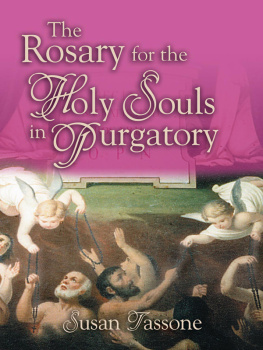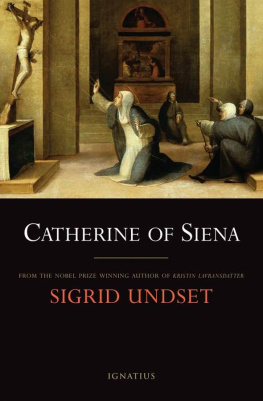Saint Catherine - Fire of Love!: Understanding Purgatory
Here you can read online Saint Catherine - Fire of Love!: Understanding Purgatory full text of the book (entire story) in english for free. Download pdf and epub, get meaning, cover and reviews about this ebook. year: 2011, publisher: Sophia Institute Press, genre: Religion. Description of the work, (preface) as well as reviews are available. Best literature library LitArk.com created for fans of good reading and offers a wide selection of genres:
Romance novel
Science fiction
Adventure
Detective
Science
History
Home and family
Prose
Art
Politics
Computer
Non-fiction
Religion
Business
Children
Humor
Choose a favorite category and find really read worthwhile books. Enjoy immersion in the world of imagination, feel the emotions of the characters or learn something new for yourself, make an fascinating discovery.
- Book:Fire of Love!: Understanding Purgatory
- Author:
- Publisher:Sophia Institute Press
- Genre:
- Year:2011
- Rating:3 / 5
- Favourites:Add to favourites
- Your mark:
- 60
- 1
- 2
- 3
- 4
- 5
Fire of Love!: Understanding Purgatory: summary, description and annotation
We offer to read an annotation, description, summary or preface (depends on what the author of the book "Fire of Love!: Understanding Purgatory" wrote himself). If you haven't found the necessary information about the book — write in the comments, we will try to find it.
Fire of Love!: Understanding Purgatory — read online for free the complete book (whole text) full work
Below is the text of the book, divided by pages. System saving the place of the last page read, allows you to conveniently read the book "Fire of Love!: Understanding Purgatory" online for free, without having to search again every time where you left off. Put a bookmark, and you can go to the page where you finished reading at any time.
Font size:
Interval:
Bookmark:

Understanding Purgatory
by
St. Catherine of Genoa
.............................. 1
...................... 15
................... 21
................... 25
.................. 29
................... 35
.............. 39
....................... 43
....................... 47
.............. 51
.................. 57
................ 61
................... 65
....................... 69
................. 73
................ 77
............... 81
............. 85
St. Catherine
and Her Works
A few years later her father died, and in the aftermath, her elder brother sought to promote the family fortunes by espousing Catherine to Giuliano Adorno, a member of another aristocratic Genoese family. Submitting to the wishes of her family, Catherine married Giuliano at age sixteen in 1463, but the marriage was unhappy due to Giuliano's infidelity and financial irresponsibility.
For the first five years of her married life, depressed at her situation, Catherine withdrew from the social life of the city. Then, encouraged by her family, she spent another five years trying to adjust to the prescribed role of an affluent young wife in Genoese society, an effort that led to increasing frustration and dissatisfaction.
Catherine's life was changed completely when she underwent a profound conversion in 1473. For several months, convinced of her appalling sinfulness, she experienced intense recollection in prayer and practiced many severe penances. During this same time, however, she began to go out into the city streets of Genoa to serve the poor there. Simultaneously, Catherine's husband Giuliano, who by now was financially bankrupt, also underwent conversion and became a Third-Order Franciscan. Now reconciled, Catherine and Giuliano agreed to a celibate marriage and moved to a small house near the large Pammatone Hospital in Genoa. There they devoted themselves without salary to caring for the patients.
After the first few years of her conversion passed, Catherine lost her preoccupation with her own sinfulness and abandoned the severe penances she had been practicing. Instead, she developed a great devotion to the Eucharist, and in May 1474 was granted permission to receive Communion daily, a rare privilege at the time.
Catherine also continued to manifest unusual spiritual gifts. From March 1476 to 1499, she fasted completely during Advent and Lent, and again, in the late 1470s, she began to experience spiritual ecstasies in which she received many of the insights that she later revealed to her associates in her teachings.
Despite these mysterious gifts, Catherine continued her work at the Pammatone with full vigor and ever increasing compassion. In 1479, Catherine and Giuliano moved into the hospital, and in 1490, Catherine was appointed Director, a post she held until 1496. Catherine was in charge of the hospital during the disastrous plague of 1493, during which four-fifths of the citizens who had remained in Genoa perished. Later that year, Giuliano died.
In the years after she relinquished the directorship of the Pammatone, Catherine continued to work at the hospital. She also began to speak to her associates about the things revealed to her in ecstatic prayer. These teachings were later written down by her admirers and transmitted in two treatises, On Purgation and Purgatory (published here as Fire of Love!) and The Spiritual Dialogue.
After several years of declining health, Catherine died on September 15, 1510. Buried in the hospital's chapel, her body was found to be perfectly intact eighteen months later when repairs to the building were being done. It continues incorrupt today. Pope Clement XII canonized Catherine in 1733. Her feast is September 15.
The influence of St. Catherine
Admired as much for her competence as a loving and efficient hospital administrator as for her mystical transports, St. Catherine of Genoa and her teachings have enjoyed considerable influence in many quarters of the Christian world.
During St. Catherine's lifetime, and under her influence, one of her admirers, Ettore Vernazza, founded the Oratory of Divine Love, a group of clerics and laymen devoted to reform of the Church through spiritual reform of individuals and care of the poor.
Later, St. Catherine's heroic example in serving the poor and the sick inspired St. Aloysius Gon- zaga, the Jesuit novice and patron saint of Catholic youth, who died caring for plague victims in Rome in 1591.
St. Catherine's mystical doctrine, contained in The Spiritual Dialogue, is thought to have influenced the great Spanish mystic St. John of the Cross. St. Francis de Sales enjoyed quoting from the Life of St. Catherine, composed shortly after her death. St. Catherine is also believed to have influenced the French Oratorian and Carmelite movements. Through the former, she influenced St. Vincent de Paul.
Interestingly, in the nineteenth century, St. Catherine's influence is traceable in Protestant as well as Catholic circles. At the beginning of the century, the founder of German Romanticism, Frederick von Schlegel, translated The Spiritual Dialogue. In England, the Anglican converts to Catholicism Cardinal Manning, Frederick Faber, and Cardinal Newman all read the treatises containing St. Catherine's doctrine and incorporated it in their own writings, Cardinal Newman most pointedly in his poem The Dream of Gerontius.
In the United States, St. Catherine provided a focus of interest for Protestant Christians in the Congregationalist and Methodist traditions, who regarded her as a role model for Christians and one that proved that perfection was attainable in the lay state. Also in America, the Redemptorist priest and founder of the Paulist order, Fr. Isaac Hecker, was a great admirer of St. Catherine, seeing in her the perfect foil to those who claimed that Catholicism promotes a mechanical piety or fosters a sanctity unconcerned with the real needs of suffering humanity in society. To the latter charge he replied forcefully:
"Read the life of St. Catherine, and in imagination fancy her in the city hospital of Genoa, charged not only with the supervision and responsibility of its finances, but also overseeing the care of its sick inmates, taking an active, personal part in its duties as one of its nurses, and conducting the whole establishment with strict economy, perfect order, and the tenderest care and love!
St. Catherine of Genoa's life combined the noblest forms of Christian service with the highest levels of contemplative prayer. May her life and her doctrine help us, too, to live out our Christian discipleship, inspired by the love of God she taught and exemplified.
Her treatise "On Purgation and Purgatory"
Communicated to her disciples toward the end of her life, the insights about Purgatory that St. Catherine received in prayer were later written down as a treatise entitled On Purgation and Purgatory (which we have retitled Fire of Love!).
Font size:
Interval:
Bookmark:
Similar books «Fire of Love!: Understanding Purgatory»
Look at similar books to Fire of Love!: Understanding Purgatory. We have selected literature similar in name and meaning in the hope of providing readers with more options to find new, interesting, not yet read works.
Discussion, reviews of the book Fire of Love!: Understanding Purgatory and just readers' own opinions. Leave your comments, write what you think about the work, its meaning or the main characters. Specify what exactly you liked and what you didn't like, and why you think so.







